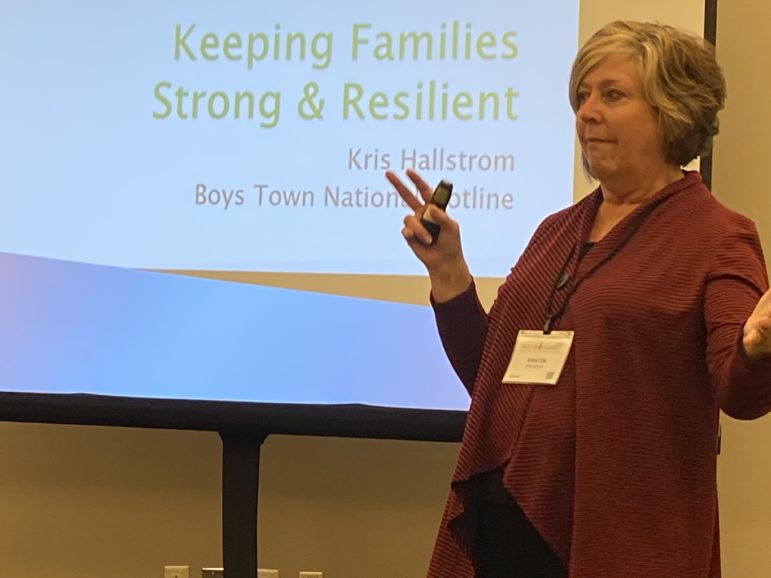
Allison Stevens
Kris Hallstrom, who manages the suicide hotline for Boys Town, says some young people call because they’re concerned about a friend.
WASHINGTON — Youth suicide is on the rise — and Kris Hallstrom, manager of a national teen suicide prevention hotline based in Nebraska, is working to stop it.
One of her strategies: Bust kids’ belief that life is perfect, a myth she said is perpetuated by television dramas and carefully curated social media accounts.
To make the point, she displayed a “prom pic” at a workshop she gave in Washington in February on preventing teen suicide. The students in the photo — a gaggle of Midwesterners — were dressed to the nines, the boys in black and white tuxes and the girls in flowing pastel gowns.
They were all smiles — despite a tornado threat that forced them to cancel their dinner plans and other typical teen drama like acne, relationship issues and school stress. Also invisible: the deeper challenges many were experiencing at the time, including eating disorders and alcoholism, divorce and death in the family.
“Kids have such an unrealistic expectation of everything being perfect,” Hallstrom said. “It’s just not a real thing.”
Her goal is to help them understand that “it’s OK to not be OK all the time” — and to give them the love, support and skills they need to cope with trauma and overcome adversity.
Youth also need to develop patience and persistence, she said. Kids today are used to “quick fixes,” especially in a world with Amazon delivery and other sources of instant gratification. “We have to help kids — and ourselves sit back and be patient,” she said.
Her work is more important than ever.
Suicide is the second leading cause of death among teens between the ages of 15 and 19, the Centers for Disease Control and Prevention (CDC) says.
And more are making serious attempts.
The suicide rate among young people between the ages of 10 and 14 declined in the early part of the century, and was stable during that period among older teens, according to the CDC.
But it has since spiked, nearly tripling among 10- to 14-year-olds between 2007 and 2017 and jumping 76% among teens who are 15 to 19, according to CDC data released in October.
Social media only part of reason
In 2017, 17% of high school students — or nearly one in five — thought seriously about attempting suicide, according to Child Trends, a youth research organization. Seven percent tried to commit suicide, and more than 2% made attempts that were serious enough to require medical attention. The prevalence of suicidal thoughts and attempts was higher among girls than boys.
Hallstrom’s hotline is supported by Boys Town, a national organization based in Nebraska that provides care and treatment to troubled youth of all genders. She spoke about her work at a national summit held in the nation’s capital by the Christopher and Dana Reeve Foundation, an organization that supports individuals and families impacted by paralysis.
The Boys Town hotline, founded in 1989, has been taking calls 24 hours a day in the 30 years since. During that time, it has received more than 9 million calls from kids in all 50 states. Counselors now respond to inquiries by text and email and manage a website.
Teens often call about suicide, relationship problems, anxiety and depression, Hallstrom said. Experts say social media and online bullying is playing a role.
One caller, for example, seriously contemplated suicide after she reluctantly texted a naked picture of herself to a boy in her high school class. He showed it to her peers, and she became a victim of online bullying.
“One night, I just said I just can’t do it anymore,” the caller, Kenna, said — and she snuck out of her house to a nearby field to kill herself. On her way, Kenna called the Boys Town hotline and changed her mind — and is now sharing her story to help others.
Some teens also call with concerns about friends, which didn’t happen as often in the past, Hallstrom said. “In today’s world, kids are aware enough and concerned enough” about each other that they make the effort to reach out,” she said. “That’s a fantastic piece of news.”
To build kids’ resilience, Hallstrom encourages adults to focus on five “c” words when caring for and guiding kids: communication, connections, confidence, control and coping.
Kids need to know how to communicate effectively and to connect with people in order to have a sense of value and belonging, she said. They also need confidence, which adults can build by praising kids more and criticizing them less. They need to be able to influence their life circumstances, and they need to develop their own skills to cope with adversity, whether that be through exercise, video games or listening to music.
“Nobody’s life is picture perfect,” Hallstrom said. But when it comes down to it, love, support and kindness “make a big difference.”































